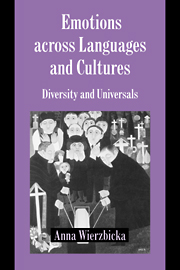Book contents
- Frontmatter
- Contents
- List of figures
- Acknowledgments
- List of abbreviations
- 1 Introduction: feelings, languages, and cultures
- 2 Defining emotion concepts: discovering “cognitive scenarios”
- 3 A case study of emotion in culture: German Angst
- 4 Reading human faces
- 5 Russian emotional expression
- 6 Comparing emotional norms across languages and cultures: Polish vs. Anglo-American
- 7 Emotional universals
- Notes
- References
- Index
6 - Comparing emotional norms across languages and cultures: Polish vs. Anglo-American
Published online by Cambridge University Press: 22 August 2009
- Frontmatter
- Contents
- List of figures
- Acknowledgments
- List of abbreviations
- 1 Introduction: feelings, languages, and cultures
- 2 Defining emotion concepts: discovering “cognitive scenarios”
- 3 A case study of emotion in culture: German Angst
- 4 Reading human faces
- 5 Russian emotional expression
- 6 Comparing emotional norms across languages and cultures: Polish vs. Anglo-American
- 7 Emotional universals
- Notes
- References
- Index
Summary
Emotion and culture
Although human emotional endowment is no doubt largely innate and universal, people's emotional lives are shaped, to a considerable extent, by their culture. Every culture offers not only a linguistically embodied grid for the conceptualization of emotions, but also a set of “scripts” suggesting to people how to feel, how to express their feelings, how to think about their own and other people's feelings, and so on.
In fact, a culture's lexical grid and its repertoire of “cultural scripts”, including “emotional scripts”, are closely related. For example, the fact that the closest Malay counterpart of angry (marah) is incompatible with violence and aggression and can be seen as, in some ways, closer to English words like resentful and upset than to angry, is no doubt related to Malay cultural attitudes to aggression, violence, and emotional self-control (cf. Goddard 1997a). In addition to the basic lexical grid, however, a culture's “emotional scripts” manifest themselves in many other ways – in the lexicon, in grammar, and in discourse.
But to be able to see, and to interpret, the diverse links between emotion and culture (cf. Kitayama and Markus 1994), we need to reaffirm “culture” as a valid, and indeed indispensable construct.
Questioning this construct, one influential writer, Eric Wolf (1994), refers in this context to Franz Boas as someone who appreciated, ahead of his time, “the heterogeneity and the historically changing interconnectedness of cultures” and was therefore able to see cultures as “a problem and not a given”.
- Type
- Chapter
- Information
- Emotions across Languages and CulturesDiversity and Universals, pp. 240 - 272Publisher: Cambridge University PressPrint publication year: 1999



